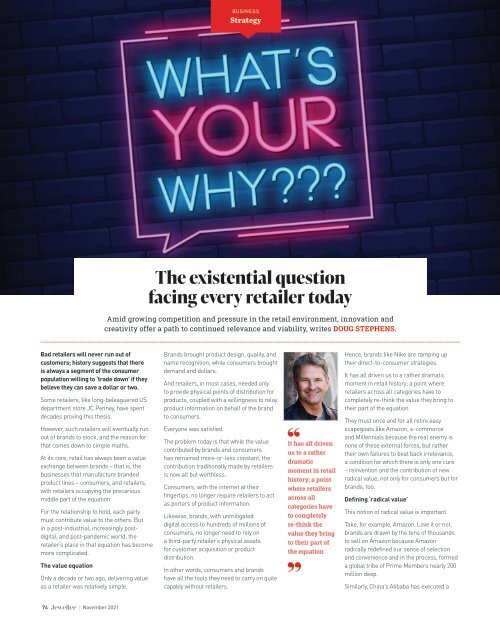You also want an ePaper? Increase the reach of your titles
YUMPU automatically turns print PDFs into web optimized ePapers that Google loves.
BUSINESS<br />
Strategy<br />
The existential question<br />
facing every retailer today<br />
Amid growing competition and pressure in the retail environment, innovation and<br />
creativity offer a path to continued relevance and viability, writes DOUG STEPHENS.<br />
Bad retailers will never run out of<br />
customers; history suggests that there<br />
is always a segment of the consumer<br />
population willing to ‘trade down’ if they<br />
believe they can save a dollar or two.<br />
Some retailers, like long-beleaguered US<br />
department store JC Penney, have spent<br />
decades proving this thesis.<br />
However, such retailers will eventually run<br />
out of brands to stock, and the reason for<br />
that comes down to simple maths.<br />
At its core, retail has always been a value<br />
exchange between brands – that is, the<br />
businesses that manufacture branded<br />
product lines – consumers, and retailers,<br />
with retailers occupying the precarious<br />
middle part of the equation.<br />
For the relationship to hold, each party<br />
must contribute value to the others. But<br />
in a post-industrial, increasingly postdigital,<br />
and post-pandemic world, the<br />
retailer’s place in that equation has become<br />
more complicated.<br />
The value equation<br />
Only a decade or two ago, delivering value<br />
as a retailer was relatively simple.<br />
Brands brought product design, quality, and<br />
name recognition, while consumers brought<br />
demand and dollars.<br />
And retailers, in most cases, needed only<br />
to provide physical points of distribution for<br />
products, coupled with a willingness to relay<br />
product information on behalf of the brand<br />
to consumers.<br />
Everyone was satisfied.<br />
The problem today is that while the value<br />
contributed by brands and consumers<br />
has remained more-or-less constant, the<br />
contribution traditionally made by retailers<br />
is now all but worthless.<br />
Consumers, with the internet at their<br />
fingertips, no longer require retailers to act<br />
as porters of product information.<br />
Likewise, brands, with unmitigated<br />
digital access to hundreds of millions of<br />
consumers, no longer need to rely on<br />
a third-party retailer’s physical assets<br />
for customer acquisition or product<br />
distribution.<br />
In other words, consumers and brands<br />
have all the tools they need to carry on quite<br />
capably without retailers.<br />
It has all driven<br />
us to a rather<br />
dramatic<br />
moment in retail<br />
history; a point<br />
where retailers<br />
across all<br />
categories have<br />
to completely<br />
re-think the<br />
value they bring<br />
to their part of<br />
the equation<br />
Hence, brands like Nike are ramping up<br />
their direct-to-consumer strategies.<br />
It has all driven us to a rather dramatic<br />
moment in retail history; a point where<br />
retailers across all categories have to<br />
completely re-think the value they bring to<br />
their part of the equation.<br />
They must once and for all retire easy<br />
scapegoats like Amazon, e-commerce<br />
and Millennials because the real enemy is<br />
none of these external forces, but rather<br />
their own failures to beat back irrelevance,<br />
a condition for which there is only one cure<br />
– reinvention and the contribution of new<br />
radical value, not only for consumers but for<br />
brands, too.<br />
Defining ‘radical value’<br />
This notion of radical value is important.<br />
Take, for example, Amazon. Love it or not,<br />
brands are drawn by the tens of thousands<br />
to sell on Amazon because Amazon<br />
radically redefined our sense of selection<br />
and convenience and in the process, formed<br />
a global tribe of Prime Members nearly 200<br />
million deep.<br />
Similarly, China’s Alibaba has executed a<br />
74 | <strong>November</strong> <strong>2021</strong>


















